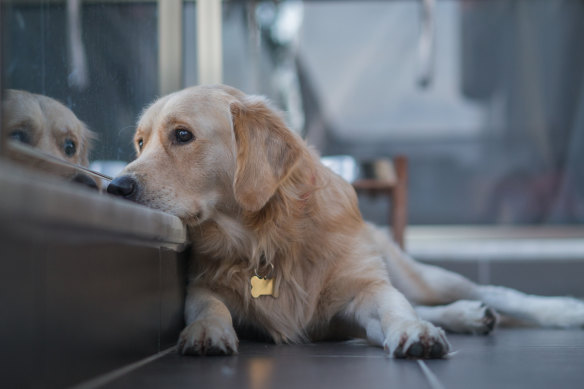This was published 3 years ago
Vets joke that COVID was organised by dogs who longed for our company. So...now what?
By Frank Robson
In pre-pandemic times, you could walk through urban streets towards the end of any work day and see dogs … waiting. They waited at fences, on lawns, driveways and verandahs, or appeared at windows with cocked ears and hopeful smiles. When their people finally got home – often 10 or 12 hours after leaving for work – the dogs danced jigs of relief and happiness. All too soon, though – despite their persuasive canine charms – the bloody people left again, and the dogs returned to waiting.

According to a study, one in five of the nation’s 4.6 million pet dogs – and a quarter of all pet cats – were acquired during the pandemic.Credit: iStock
Then came COVID-19. All over the world (and especially in NSW and Victoria), humans abandoned their mystifying daily exoduses to places unknown and stayed home 24/7 – sometimes for months on end. Dogs were ecstatic. It didn’t matter that their people just sat about in soft clothing watching TV, or baking things, or writhing about, doing strange exercises. For dogs, what mattered was that they were no longer alone. People were talking to them, scratching their ears, feeding them treats, taking them to the park. Suddenly, every day was Saturday!
People began adopting rescue animals or buying puppies like never before. (According to Animal Medicines Australia’s Pets and the Pandemic study, an amazing one in five of the nation’s 4.6 million pet dogs – and a quarter of all pet cats – were acquired during the pandemic.)
Dr Anne Quain, a veterinarian and lecturer at the University of Sydney’s School of Veterinary Science, reckons the rise in dog ownership during COVID is “extraordinary, unprecedented” – and a pointer to how lockdowns have benefited dogs in general. “There’s a running joke in vetland that COVID was actually organised by dogs,” she laughs. “It’s also helped people realise that life isn’t much fun when you’re locked up in the same space 24 hours a day, like some dogs.”
The downside, of course, is that with lockdowns seemingly coming to an end, and many people back at work, there are even more lonely dogs wondering what happened to the good times. “Imagine being an alien from another planet,” says Quain. “The people looking after you don’t speak your language and have a different biology, yet lead you to believe they’ll [be with you] 24/7. Then the rules just suddenly change.”
Separation anxiety leads some dogs to chew up furnishings, dig giant holes, or bark and howl their misery to the world. Quain urges people not to punish such behaviour, because it never works: “Dogs don’t associate punishment with what they’ve done, and it can destroy their trust in the relationship.”
Instead, she suggests trying to negotiate more flexible working hours, or working as much as possible from home, or – where it’s permitted – taking your grieving pooch to work with you at least once a week. Failing any of that, she recommends getting advice from a vet or trainer.
To read more from Good Weekend magazine, visit our page at The Sydney Morning Herald, The Age and Brisbane Times.
The best of Good Weekend delivered to your inbox every Saturday morning. Sign up here.